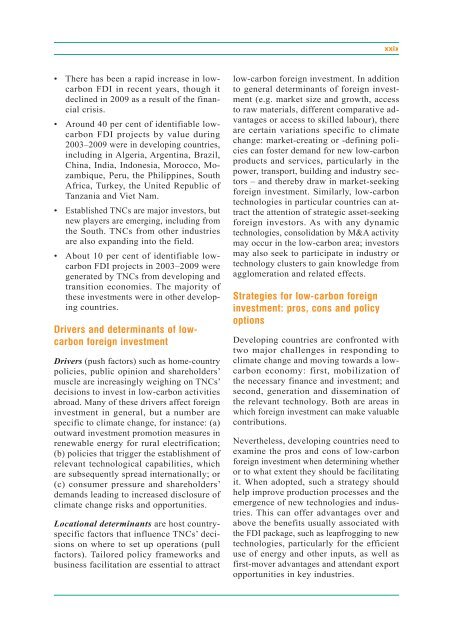UN World Investment Report 2010 - Office of Trade Negotiations
UN World Investment Report 2010 - Office of Trade Negotiations
UN World Investment Report 2010 - Office of Trade Negotiations
You also want an ePaper? Increase the reach of your titles
YUMPU automatically turns print PDFs into web optimized ePapers that Google loves.
•<br />
•<br />
•<br />
•<br />
There has been a rapid increase in lowcarbon<br />
FDI in recent years, though it<br />
declined in 2009 as a result <strong>of</strong> the financial<br />
crisis.<br />
Around 40 per cent <strong>of</strong> identifiable lowcarbon<br />
FDI projects by value during<br />
2003–2009 were in developing countries,<br />
including in Algeria, Argentina, Brazil,<br />
China, India, Indonesia, Morocco, Mozambique,<br />
Peru, the Philippines, South<br />
Africa, Turkey, the United Republic <strong>of</strong><br />
Tanzania and Viet Nam.<br />
Established TNCs are major investors, but<br />
new players are emerging, including from<br />
the South. TNCs from other industries<br />
are also expanding into the field.<br />
About 10 per cent <strong>of</strong> identifiable lowcarbon<br />
FDI projects in 2003–2009 were<br />
generated by TNCs from developing and<br />
transition economies. The majority <strong>of</strong><br />
these investments were in other developing<br />
countries.<br />
Drivers and determinants <strong>of</strong> lowcarbon<br />
foreign investment<br />
Drivers (push factors) such as home-country<br />
policies, public opinion and shareholders’<br />
muscle are increasingly weighing on TNCs’<br />
decisions to invest in low-carbon activities<br />
abroad. Many <strong>of</strong> these drivers affect foreign<br />
investment in general, but a number are<br />
specific to climate change, for instance: (a)<br />
outward investment promotion measures in<br />
renewable energy for rural electrification;<br />
(b) policies that trigger the establishment <strong>of</strong><br />
relevant technological capabilities, which<br />
are subsequently spread internationally; or<br />
(c) consumer pressure and shareholders’<br />
demands leading to increased disclosure <strong>of</strong><br />
climate change risks and opportunities.<br />
Locational determinants are host countryspecific<br />
factors that influence TNCs’ decisions<br />
on where to set up operations (pull<br />
factors). Tailored policy frameworks and<br />
business facilitation are essential to attract<br />
xxix<br />
low-carbon foreign investment. In addition<br />
to general determinants <strong>of</strong> foreign investment<br />
(e.g. market size and growth, access<br />
to raw materials, different comparative advantages<br />
or access to skilled labour), there<br />
are certain variations specific to climate<br />
change: market-creating or -defining policies<br />
can foster demand for new low-carbon<br />
products and services, particularly in the<br />
power, transport, building and industry sectors<br />
– and thereby draw in market-seeking<br />
foreign investment. Similarly, low-carbon<br />
technologies in particular countries can attract<br />
the attention <strong>of</strong> strategic asset-seeking<br />
foreign investors. As with any dynamic<br />
technologies, consolidation by M&A activity<br />
may occur in the low-carbon area; investors<br />
may also seek to participate in industry or<br />
technology clusters to gain knowledge from<br />
agglomeration and related effects.<br />
Strategies for low-carbon foreign<br />
investment: pros, cons and policy<br />
options<br />
Developing countries are confronted with<br />
two major challenges in responding to<br />
climate change and moving towards a lowcarbon<br />
economy: first, mobilization <strong>of</strong><br />
the necessary finance and investment; and<br />
second, generation and dissemination <strong>of</strong><br />
the relevant technology. Both are areas in<br />
which foreign investment can make valuable<br />
contributions.<br />
Nevertheless, developing countries need to<br />
examine the pros and cons <strong>of</strong> low-carbon<br />
foreign investment when determining whether<br />
or to what extent they should be facilitating<br />
it. When adopted, such a strategy should<br />
help improve production processes and the<br />
emergence <strong>of</strong> new technologies and industries.<br />
This can <strong>of</strong>fer advantages over and<br />
above the benefits usually associated with<br />
the FDI package, such as leapfrogging to new<br />
technologies, particularly for the efficient<br />
use <strong>of</strong> energy and other inputs, as well as<br />
first-mover advantages and attendant export<br />
opportunities in key industries.

















